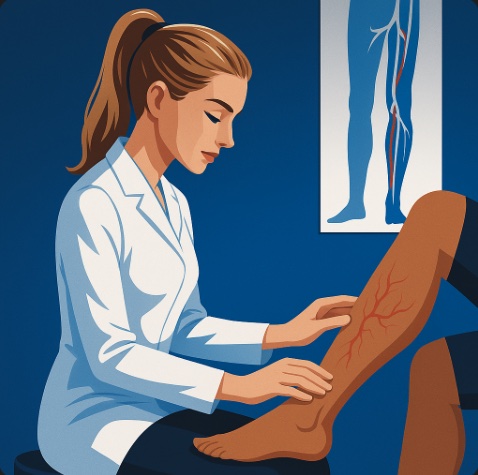What is Peripheral Vascular Disease?
PVD is a term used to describe the narrowing of blood vessels that are outside the brain and heart. It primarily affects the arteries supplying blood to the kidneys, legs, arms and stomach. Atherosclerosis is the most common cause, in which fatty deposits accumulate within the arteries and restrict blood flow.
Symptoms and Treatment of Peripheral Vascular Disease
The severity of PVD will determine the symptoms. Common signs include:
- Intermittent Claudication Pain in the legs or cramps, particularly when walking or exercising.
- Leg Weakness or Numbness: A reduced blood flow may cause tingling and weakness in the affected leg.
- Coldness of Lower Extremities: Due to poor circulation, one leg or foot can feel colder.
- Wounds That Heal Slowly : A reduced blood flow can cause wounds to heal slowly, increasing the chance of infection.
- Skin discoloration: Affected skin areas may appear blue, pale or darkened.
- Hair loss on legs or feet: Poor blood circulation can cause reduced hair growth.
- A weak or absent pulse in the legs or feet: Blood circulation restriction can make it difficult to detect a heartbeat.
Causes of the Disease and Risk Factors
PVD is influenced by several factors, including
- Atherosclerosis: The primary cause of atherosclerosis is plaque buildup in the arteries.
- Diabetes: High blood sugar levels can damage blood vessels.
- Smoking Smoking damages the arteries and increases the risk for PVD.
- Hypertension (High Blood Pressure): Increases the strain on blood vessels.
- High Cholesterol Causes plaque to build up, narrowing arteries.
- Obesity Increased weight puts strain on the circulatory systems.
- Sedentary Lifestyle: Blood flow can be affected by a lack of exercise.
- Genetics A family history of cardiovascular disease can increase the risk.
Diagnosis for Peripheral Vascular Disease
Early diagnosis is key to effective treatment. Diagnostic tests include:
- Ankle Brachial Index: Compares the blood pressure of the ankle and arm in order to detect blockages.
- Ultrasound imaging: Detects narrowing and blockages of the arteries.
- Angiography Visualizes blood flow using contrast dye and X rays.
- Magnetic Resonance Angiogram (MRA) and CT Angiography: Shows the blood vessels in detail.
Treatment options for PVD
PVD treatment focuses on improving circulation and reducing symptoms. Options include:
Modifications to Lifestyle
- Stop Smoking: Improves circulation and reduces disease progress.
- Healthy diet: Low fat, high fiber diets with fruit, vegetables, whole grains, and low-fat dairy products support heart health.
- Exercise Regularly: Walking or supervised exercise programs can improve blood circulation and reduce symptoms.
- Weight management: Reduces the strain on your circulatory system.
Medications
- Antiplatelet Drugs Clopidogrel or aspirin prevent blood clots.
- Cholesterol-Lowering Drugs: Statins help reduce plaque buildup.
- Blood pressure Medications: Lowering high blood pressure reduces the stress on the arteries.
- Cilostazol, Pentoxifylline and other drugs that increase blood flow in the limbs: Increase walking distance.
Procedures with Minimal Invasiveness
- Angioplasty Stenting: Small balloons are used to widen narrowed arteries.
- Atherectomy A procedure for removing plaque from the arterial walls.
Surgical interventions
- Bypass surgery: Creates a new pathway for blood circulation around blocked arteries.
Prevention of Peripheral Vascular Disorder
Preventive strategies include:
- Weight management is important to maintain a healthy body weight.
- Exercising regularly.
- Controlling blood sugar levels (for diabetics).
- Manage cholesterol and blood pressure levels.
- Avoid smoking
How to Know When to Visit a Doctor
Seek medical attention if you experience:
- Leg pain that is severe when walking or resting.
- Wounds that do not heal on your legs or feet
- Skin discoloration, ulcers, or gangrene.
- Leg weakness or numbness.
Peripheral Vascular Disease can be a serious, but treatable condition. Early diagnosis and treatment can improve your quality of life, and help prevent complications. You should schedule an appointment to have a personalized treatment plan and evaluation with your healthcare provider if you suspect PVD.







